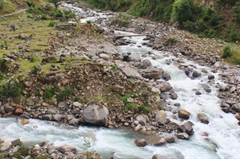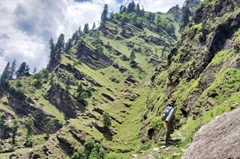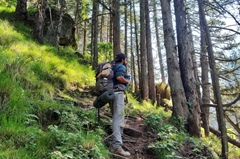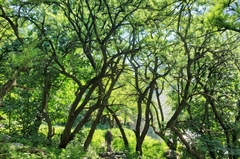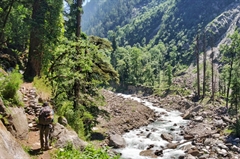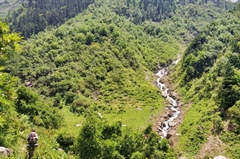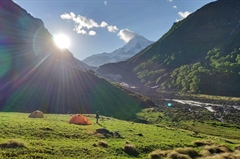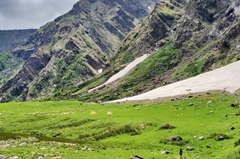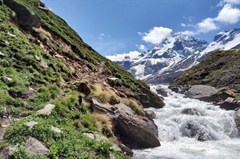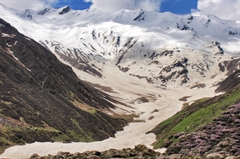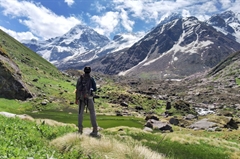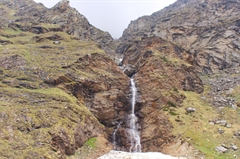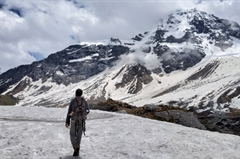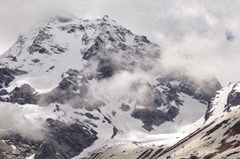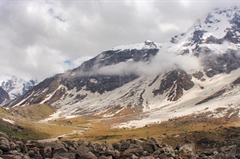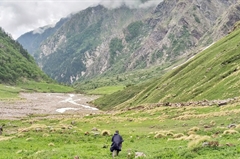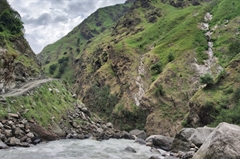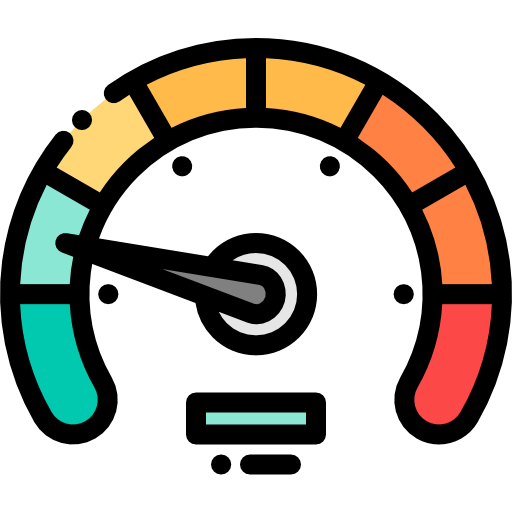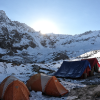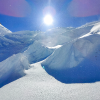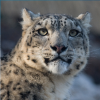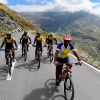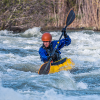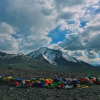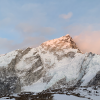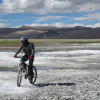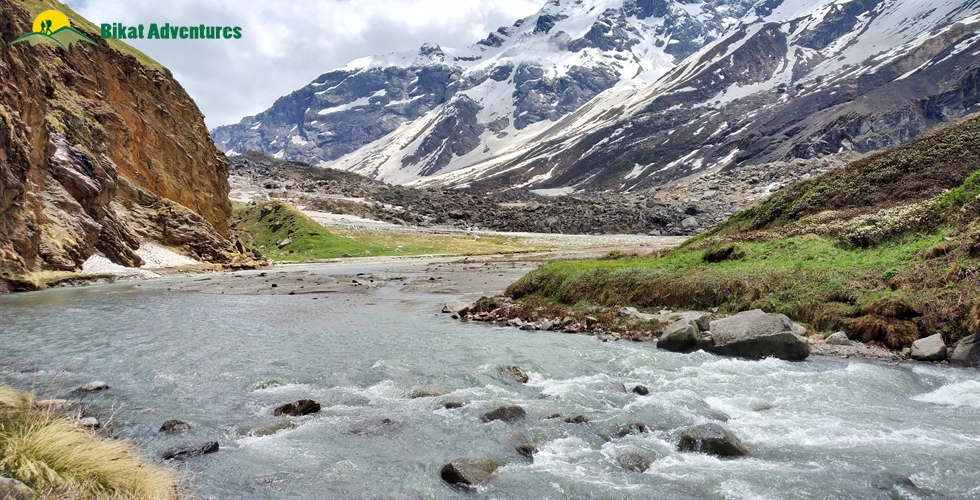
Dev Kyara Trek
Hidden Gem of Uttarakhand
Available Batches
Brief Description
Brief Itinerary
Detailed Itinerary
Day 1
Arrive in Sankri
Distance: 210 kms (Dehradun to Sankri)
Duration: 7-8 hours
Arrive in Sankri. If you opt for transportation from us then we will board a vehicle from Dehradun ISBT to Sankri. The pick up point will be Dehradun ISBT. The total journey of 210 km between Dehradun and Sankri will be completed in 7-8 hours. Spend the night at a hotel/guesthouse in Sankri.
Day 2
Sankri to Boincha(6762 ft) to Obra (7641 ft)
Distance: 35 kms + 3.4 kms
Duration: 3 hours drive + 3 hours trek
The very first day of the trek starts with a brief drive of merely 3 hours till you reach Boincha, which is the starting point of the trek. The ride takes you through pictersque villages of the Sankri. Boincha is a merging point of two rivers, Dibra River and Supin river. The trail is towards the right alongside the Dibra Gad river. This particular day will be very easy in terms of difficulty, it is always advisable to take it easy in the initial days, especially on day one. After a 30min trek, there will be a concrete bridge that takes you to the opposite side of the Dibra River. Once you cross the bridge there is a small section of steep ascent which merges with another trail. So after a while, you will be heading back to the main trail on the other side after crossing one more concrete bridge. From this point the trek is pretty basic, there is a gradual ascent to the campsite. There are some spots for you to sit and enjoy alongside the Dibra Gad river. The campsite is known as Obra Thatch which is an open field at the centre of the valley. There is also a small wooden temple of Obra Devi right next to one of the huts made by the villagers. So retire for the night in tents.
Day 3
Obra (7644 ft) to Bhawa Waterfall (11,234 ft)
Distance: 8.13 kms
Duration: 7 hours
This will be the longest day of the whole trek and also in terms of height gain. Once you leave the Obra campsite you will be entering a deep enchanting pine forest which is a continuous ascend. The ground level of the forest is covered with long grasses which makes it very engaging till the time you cross the forest section. As it’s a long day so break it up into two parts, the first part is basically before the lunch which doesn’t offer much change except there are some sections pine and maple trees. If you wish to do this trek in pre-monsoon then you will come across strawberry bushes. Following a steep ascend through boulders the trek changes altogether. The valley opens to a large open ground surrounded giant Mountains. At a distance, the snow-capped mountains start to show. You now enter the glorious campsite named as Bhawa waterfall, it is spectacular. It is a giant meadow right beside a waterfall which is cutting through a Mountain surface. While the other side of the valley is so pretty to look at, it is a forest filled with Birch trees. The sight which is a combination of birch trees and long glades of grass is mesmerising. Retire yourself for the night after a long exhausting day in this one amazing campsite.
Day 4
Bhawa Waterfall (11,234 ft) to Dev Kyara (13,451 ft) - 5 km, 5 hrs
Distance: 5 kms
Duration: 5 hours
Today's start from the early morning view to reaching Devkyara campsite, it is like a fairy-tale coming true. As the first rays of the Sun fall on the lush green fields of Bhawa, it will leave you awe-struck. Once you start your trek, the open valleys start unfolding the glorious lush green meadows in the center of the valley with massive mountains on either side shaped like a wall. One of the major highlights will be the number of waterfalls you will come across, not one or two, it is almost over twenty, not so small or not so big but it will keep coming till you reach the Devkyara campsite. The further you walk the more you get closer to Mt. Ranglana. The Dibra River at some sections kisses the exact trail you are walking on. If the season is right then you will be walking endless fields of flowers, some red, yellow and even blue. There is are a few sections with boulder crossing especially just before you reach Devkyara campsite. During pre Monsoon, there are good chances you will be walking on snow especially from April to May. Just after the boulder zone, there is a descending part which takes you to the Devkyara campsite. It is so massive that it doesn’t feel like you are inside a valley, so this is like a base camp to Ranglana peak. The presence of Ranglana peak gives the vibe of an alpine campsite, it means camping at very high altitude right next to snow-capped peaks which generally happens during a Mountaineering expedition. There are many more snow-capped peaks that are visible which is stunning. Explore the campsite and retire for the night.
Day 5
Explore Dev Kyara and back to Bhawa Waterfall Campsite (11,234 ft)
Distance: 5 kms
Duration: 5 hours
Get up early for this day, so that you can trek further up to a point which takes around two hrs from the campsite, leave behind your bags because you will be coming back to proceed towards the previous campsite which is Bhawa waterfall. The trail ahead takes you to a big shade under a rock where it is said it can accommodate more than a hundred people easily. The word Dev Kyara means Settling point for God. After visiting this place come back to Devkyara campsite and continue your journey towards Bhawa waterfall campsite which will merely take around two hours. Bhawa waterfall is such a pretty campsite that another day camping is not bad at all. While coming down to Bhawa waterfall from Devkyara campsite you get a different perspective altogether than going up to Devkyara. The greenery of the opposite end of the valley leaves you speechless, the good part is it doesn’t feel like you’re repeating the trail. So retire yourself at the Bhawa waterfall for your last night of the trek with the mesmerizing view of the Bhawa campsite.
Day 6
Bhawa Waterfall (11,234 ft) to Boincha (6762 ft) to Sankri
Distance: 12 kms + 35 kms
Duration: 6 hours trek + 3 hours drive
This last day will be a long and continuous descend till the very starting point of this trek. So be careful on your knees because going down your whole body weight comes on your legs. The last day gives you a good chance to relive the forestry trail one last time, so repeating a trail is not bad at all. You will be going back on the same trail you walked in first two days. Packed lunch will be provided to you as you will be reaching Boincha by late afternoon and then you will be ending your journey by taking a vehicle to head back to Sankri village which is again a 3 hour drive.
Day 7
Depart from Sankri. Drive to Dehradun.
Distance: 210 kms
Duration: 7-8 hours
If you opt for transportation from us then we will start our drive to Dehradun before 8am. You will reach Dehradun by evening. So plan your further travel accordingly.
What's Included
- Food as per menu on the trekking days
- Forest Permits/Camping Charges, if any (upto the amount charged for Indian nationals)
- Tents, Sleeping bags, Sleeping mats as required
- Safety Equipment includes static rescue rope, seat harness, carabiners, pulleys
- Trek guide, cook, helpers, and porters for carrying common supplies
- Mountaineering course certified Trek Leader with Wilderness Emergency Responder & Rescue. course from NIM Uttarkashi
What's Not Included
- Portage of personal bags during the trek
- Cost of any kind of Travel Insurance.
- Any Expense of personal nature.
- Any Expense not specified in the inclusions list
- Meals during road journeys
- Transportation from Dehradun to Sankri and back to Dehradun.
Are you Eligible for this Adventure?
BRS Level Required
This makes it mandatory for you to have high-altitude experience of preferably multiple treks marked at level 3 on the BRS. The altitude, the terrain and the nature of the climb demand a certain level of skill and a need for you to be aware of how your body reacts to the various features of high altitude environment.
If you do not know what level of BRS trek would suit you best, worry not! Fill out this Form:
we will send you a progression chart to help you comfortably get out of your comfort zone in order to level up and ultimately reach your highest potential in the big, bad world of outdoor adventure.
Packing List
This is a list of essential items for individuals doing the trek with Bikat Adventures. This list contains only those items which the participants are required to bring with them. The list excludes those items which are provided by Bikat Adventures on the trek. We have divided the items into five categories. All the items in the list are essential except for those marked as optional.
Trekking Gear
- Ruck sack bag with rain cover. Qty -1
- Day Pack Bag - Recommended for treks with summit day
- Head Torch with spare Batteries. Qty -1
- U V protection sunglasses. Qty -1 Here is how you can choose the best sunglasses for trekking.
- Water Bottles: 2 bottles of 1 liter each
Footwear
- Non-skid, deep treaded, high-ankle trekking shoes Qty -1
- Pair of light weight Slipper/Sandals Qty -1
Clothing
- Quick Dry Warm lower or Track Pants. Qty - 2
- Full sleeves T-shirts/ Sweatshirts. 1 for every 2 days of trekking
- Pair of thick woolen socks. 1 pair for every two days of trekking
- Thermal Body warmer Upper & Lower. Qty-1
- Undergarments. Qty - 1 for every day of trekking
- Warm jacket closed at wrist & neck .Qty-1
- Full sleeves sweater. Qty -1
- Rain wear ( Jacket & Pants ) . Qty-1
- Pair of waterproof, warm gloves. Qty-1
- Woolen cap. Qty-1
- Sun shielding Hat. Qty -1
Toiletries
- Personal toiletries kit (Small Towel, Toilet paper, paper soap, Bar soap, toothbrush, toothpaste, cold cream, etc.)
- Sun screen lotion small pack. Qty -1 Here is your Sun Protection 101 to stay safe in the bright sunny outdoors.
- Lip Balm small pack. Qty-1
Utensils
- Small size, Light weight & Leak proof lunch box. Qty-1
- Plate. Qty- 1
- Spoon.Qty-1
- Tea/Coffee (plastic) Mug.Qty-1
Miscellaneous
- Camera (Optional)
- Carry your medicines in plenty in case you have any specific ailment. Consult your doctor before joining the trek.
- Dry fruits, Nuts, Chocolate bars (Optional)
Frequently Asked Questions
Why Bikat?
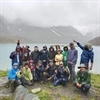

Small Group Size
Our batch sizes are capped at 15 for smaller treks with the trek leader and trekker ratio of 1:8. This ratio, in our years of experience, has proven to deliver the best trekking experience for individuals as well as groups. Capping the size of the group ensures individual attention to each trekker so that no signs of distress or need during the trek go unnoticed. It also helps to form a more cohesive cohort with better group energy which helps define the rhythm and pace of days on the trek. As you go higher up on the BRS scale, since the stakes are higher, expeditions have an even smaller group size with the ratio of expedition leader to climber set at 1:2.
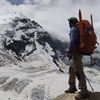

Qualified Trek Leaders
We follow a rigorous regime of hiring and training our experts in the field. Each trek leader is a certified mountaineer with years of experience in the field. In addition to their qualification, they also go through practical and situational training to tackle any and all kinds of sudden conditions that may present themselves on the ground. Being unpredictable is the core nature of the mountains but being ready for any circumstance as best as possible is a controllable asset that we try to nurture. Our field experts are also trained in basic medicine and first-aid response. Watch: Forerunners - The Making of A Trek Leader At Bikat Adventures
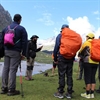

Guided Progression
Since Bikat Adventures is a learning-based organization, we help you climb up the ladder of difficulty within the sphere of outdoor adventure systematically. Our on-ground training modules are designed to handhold you through the upskilling process so that you are ready to take on bigger challenges.
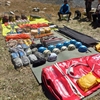

Equipment Quality and Check
All the gear used on our treks and expeditions is tried and tested, maintained for good quality, and is overall top-notch in quality and condition. We are continually looking to obtain the best of everything there is in the market so as to ensure optimum safety.
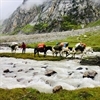

Support Systems
Along with the staff you see on-ground, we have a team of superheroes working in the background to give you the best experience possible. Our background team also comprises local staff from each area who know the region best. Having local support helps with studying the area, pre-planning, execution, and in receiving timely support in case of emergencies in these remote locations.
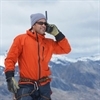

Communication
Our on-field staff is in constant contact with our teams based in primary locations so as to eliminate any avoidable delay in reaching additional help and support when required. We try to use the best tools for communication available, including satellite phones, in regions where they are not restricted.
What our customers Say
Cancellation Policy
Cash refund
Cancellations up to 60 days prior to departure date
Between 60 days upto 30 days prior to departure date
Between 30 days upto 10 days prior to departure date
Less than 10 days prior to departure date
Voucher refund
Cancellations up to 30 days prior to departure date
Between 30 days upto 15 days prior to departure date
Between 15 days upto 10 days prior to departure date
Less 10 days prior to departure date
- Cash refund is applicable only in case of bookings made without using any promotional offer code or Cancellation Vouchers or Discounts
- This is only a brief of cancellation terms. For finer details please refer Detailed Cancellation Policy.
Blog Posts
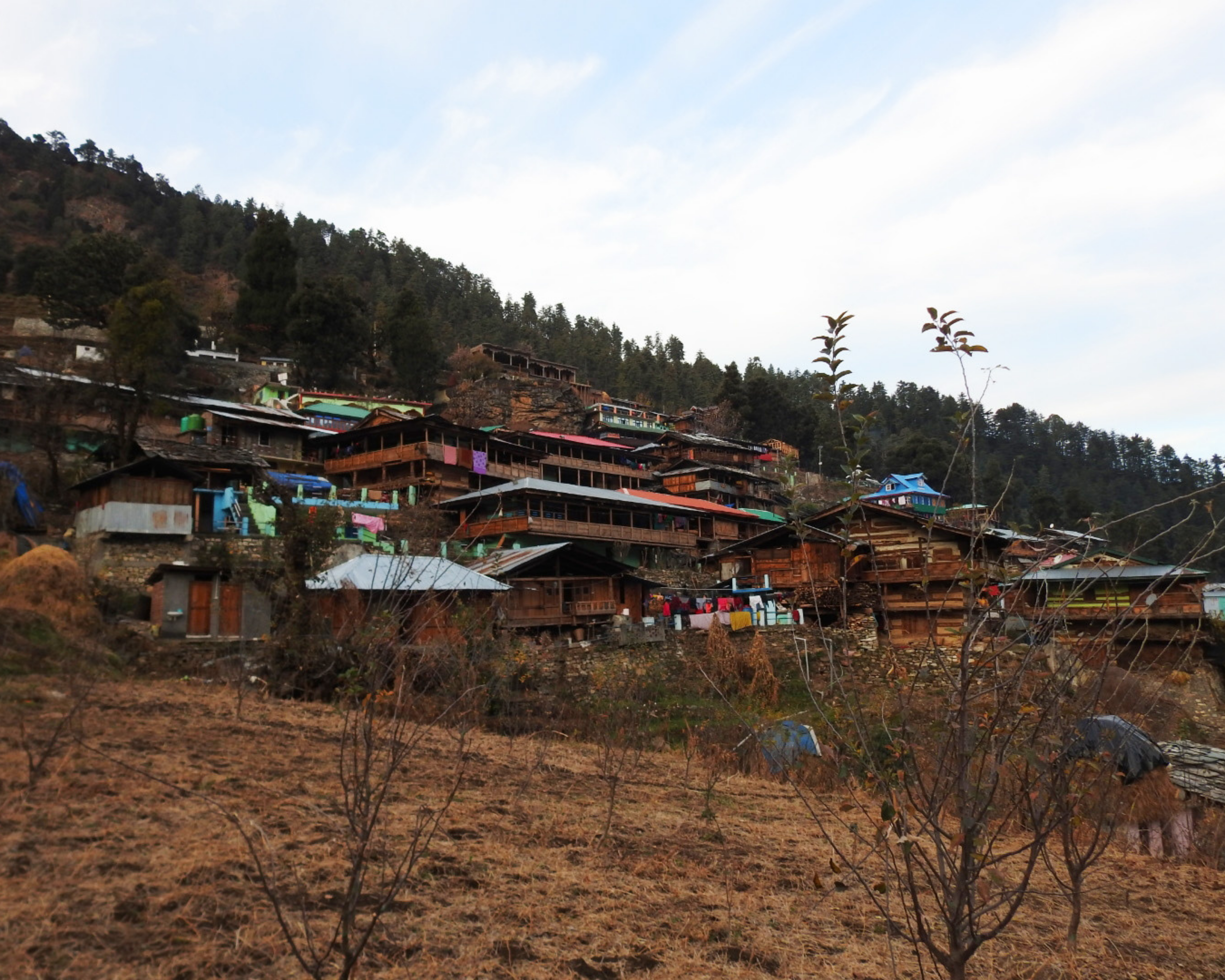
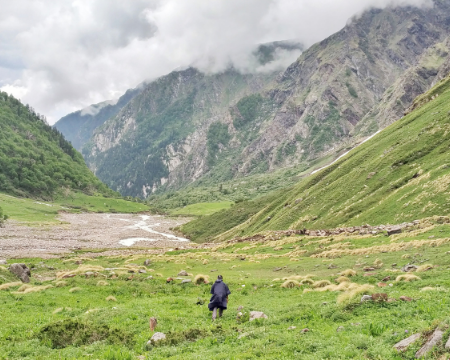
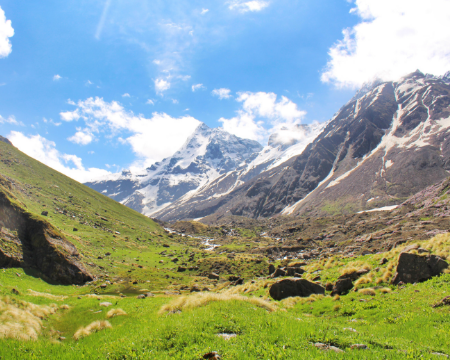
Similar Adventures
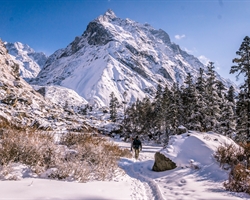
Har ki Dun Trek
A Gorgeous River Valley Trek for Beginners
Uttarakhand
7 Days
BRS 3
3500 m
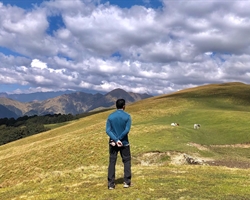
Ali Bedni Bugyal Trek
The Next Chapter of Roopkund
Uttarakhand
6 Days
BRS 3
3535 m
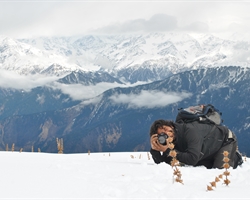
Dayara Bugyal Trek
A Short Escape for a Long Weekend
Uttarakhand
5 Days
BRS 2
3750 m
